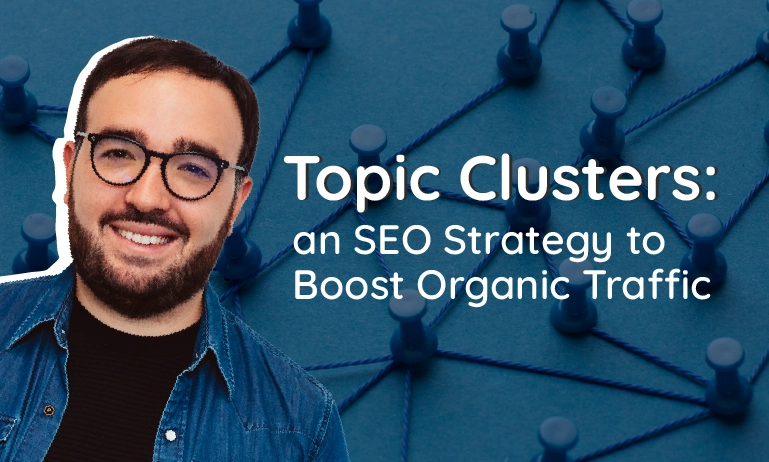Topic Cluster: SEO Strategy to Boost Organic Traffic

Table of Contents
In my role as an SEO Consultant, I’m often confronted with a recurring question: despite the constant effort in publishing lots of pieces of content, why does my website seem to be invisible to Google?
My usual response revolves around the fact that in today’s crowded digital space, breaking through on Google presents an increasingly complex challenge for new websites.
Assuming your site is already technically sound – and if it’s not, an SEO Audit might be necessary to identify critical issues, errors, and the overall optimisation status – the primary objective shifts towards establishing authority for your domain and enhancing its relevance within a specific niche.
For example, if you’re an accountant, it could be worthwhile to devote significant space on your blog to the intricate nuances of the tax world. For a plastic surgeon, the focus might be on everything related to cosmetics and overall body well-being, instead.
To attain this objective, a strategy I’ve successfully explored in recent years involves leveraging Topic Clusters and Pillar Pages. Pillar Pages serve as comprehensive guides on specific topics, serving as reliable references for users and search engines alike.
Conversely, Topic Clusters are clusters of interconnected content orbiting around the Pillar Page, creating an internal link network that amplifies the overall relevance of the site.
This approach succeeds for several reasons. Firstly, it signals to Google that your site is an authoritative source on a specific subject, bolstering its confidence in indexing your pages.
Secondly, this structural setup streamlines navigation for users and search engines, enticing them to explore your site more thoroughly, leading to increased dwell time and reduced bounce rates.
Now, let’s dive into the intricacies of this intriguing topic.
Topic Clusters: What Are They?
As mentioned above, a Topic Cluster is a strategic grouping of interconnected pages, all centred around a broad topic, also known as the ‘pillar.’
The foundation of this structure involves creating two types of content: the Pillar Page and Topic Clusters. The first is a comprehensive and authoritative page that serves as the central hub, delving deeply into the main topic. This page is intricately linked to various sections of the Cluster, each delving into specific topics related to the main theme. The synergy between the Pillar Page and the Topic Cluster not only establishes thematic authority but also provides a cohesive and user-friendly experience for visitors seeking comprehensive information on a particular subject.
This approach not only aligns with the evolving algorithms of search engines but also satisfies the user’s desire for in-depth and well-organised content.

How do Topic Clusters work?
Pillar Pages serve as the cornerstone in the structure of Topic Clusters, playing a crucial role in defining a website’s authority and SEO performance.
At their core, Pillar Pages are comprehensive and authoritative pieces of content that act as the central hub for a specific topic.
Topic Clusters are meticulously crafted to delve into the broad theme, serving as a reference resource for users seeking in-depth information. Besides being a valuable resource for visitors, Topic Clusters provide a significant SEO boost.
Firstly, they contribute to establishing authority on a particular topic, signalling to search engines that your website is a credible source of information. Secondly, Pillar Pages enhance overall SEO performance by providing a structured and interconnected framework for related Cluster content.
Through strategic internal linking, Pillar Pages distribute link equity to supporting Cluster content, elevating the SEO value of the entire Topic Cluster. Essentially, these pages not only fulfil the user’s intent by offering comprehensive insights but also align with search engine algorithms that prioritize well-organised and context-rich content.
By adopting this strategy, websites can establish a solid foundation for a successful content strategy, improving both user satisfaction and visibility on search engines. Increased visibility translates into more clicks on the web and, ultimately, an uptick in conversions (purchases, form submissions, etc.).
What impact do Topic Clusters have on the SERP?
Search engines, led by Google, are increasingly leaning towards semantic search, aiming to understand the context and intent behind user queries. In this landscape, Topic Clusters represent a sophisticated and contextual approach to content organisation.
By grouping related material around a central Pillar Page, websites can present a unified front on a specific topic, signalling to search engines their expertise and authority in that particular subject.
This alignment with search engine algorithms is not just theoretical; it directly influences Google’s SERP positioning factors. Moreover, Google’s preference for comprehensive and well-organised content positions Topic Clusters as a strategic methodology for improving search engine rankings. From the user’s perspective, Topic Clusters offer a seamless and satisfying experience, providing a single destination for exhaustive information on a particular topic.
Indeed, the era of shallow content and keyword stuffing, the use of keywords as filler, has passed. Expertise, authority, and trust take centre stage. Topic Clusters and Pillar Pages provide an excellent way to enhance your site’s positioning and build authority.
Implementing Topic Clusters: Practical Tips
Executing an effective strategy based on Topic Clusters requires a careful blend of strategic planning, keyword research, and content creation. Similar to drafting any SEO-oriented editorial plan, begin with thorough keyword research to identify suitable pillar topics aligned with your business objectives.
These topics should be broad and evergreen, serving as the foundation for your Topic Clusters. Once identified, develop comprehensive Pillar Pages that delve deep into the chosen topics, providing value and solidifying your site as a reliable authority.
Simultaneously, explore subtopics within each pillar that can be addressed through the Topic Cluster. These subtopics should be specific, covering niche aspects of the overall theme.
While creating the Topic Clusters, ensure a seamless connection with the corresponding Pillar Page, thus forming a cohesive network of information.
Implementing a robust internal linking strategy is crucial: strategically place links within the content and optimize anchor text to maximize contextual relevance.
To keep information current and engaging, regularly update and expand both the Pillar Page and the Topic Cluster. Following these practical tips will not only enhance your website’s structure but also strengthen its visibility and authority in your industry.
Expected Results of the Topic Cluster Strategy
Implementing a Topic Cluster strategy promises multiple benefits for the performance and visibility of your website. Firstly, by organising content around comprehensive Pillar Pages and strategically connected Cluster Contents, you are likely to see an improvement in search engine rankings. The structured and interconnected nature of Topic Clusters aligns with search engine algorithms, signaling the authority and relevance of your website. This, in turn, can lead to an increase in organic traffic, as your content becomes more easily discoverable by users seeking information in your industry. Additionally, the user-focused design of Topic Clusters enhances the overall experience for visitors, potentially increasing the time spent on the site and interaction. A well-implemented Topic Cluster strategy not only supports SEO efforts but also establishes your website as a reference in your industry, promoting trust and credibility among your audience.
Over time, the cumulative impact of improvements in rankings, increased traffic, and user satisfaction could contribute significantly to the overall success and visibility of your online presence.

Topic Cluster and Pillar Page: Case Study
Among the various examples I could share, I recall that of a sports blog active for two years. Despite publishing about 25 articles per week and making significant investments in content creation, the blog struggled to achieve tangible results.
The main reason for this issue was the lack of a robust SEO strategy in their articles, especially considering the saturation in the sports information sector. This highlights the importance of writing for an editorial project not just for the sake of it but incorporating fundamental SEO principles to achieve concrete results.
Search engine optimisation plays a crucial role in guiding editors to create content that addresses people’s questions, contributing to gaining recognition from both users and search engines on a specific topic. Building relevance and authority becomes crucial for online success.
After a thorough analysis, during which we identified the topics to cover and structured them in an SEO-oriented editorial calendar, introducing Pillar Pages and Topic Clusters on specific subjects, in a subsequent phase, we shared with content writers the best SEO practices to follow in articles (heading structure, meta-data, internal linking, etc.).
This approach began to yield results after 3-4 months, with a gradual increase in clicks from Google search results and the subsequent organic traffic to the site. The difference between articles written without SEO attention and those following best practices became evident. While the former yielded no results, the latter strategy had the potential for success. Original articles, created by true experts and adhering to the best SEO practices, allowed the site to gain recognition from Google, establishing legitimacy, authority, and relevance in the sports field. Growing authority contributed to increased visibility on search engines, simplifying online presence for specific user queries.
In short, how do you turn things around when content isn’t working? Picture this: an editorial calendar, built on SEO principles, adorned with Pillar Pages and Topic Clusters. But it’s not just about content; it’s about setting the rules. SEO guidelines become your North Star, providing direction to your copywriters. Length, structure, keywords: it’s the harmonious fusion that transforms simple words into something that works digitally.
If your content continues to play hide-and-seek despite having the best editors on board, perhaps it’s time to bring in the ‘SEO cavalry.‘ Contact me today for SEO consultation: fill out the contact form on the Contacts page or write at [email protected] to understand how you can enhance your content strategy.
